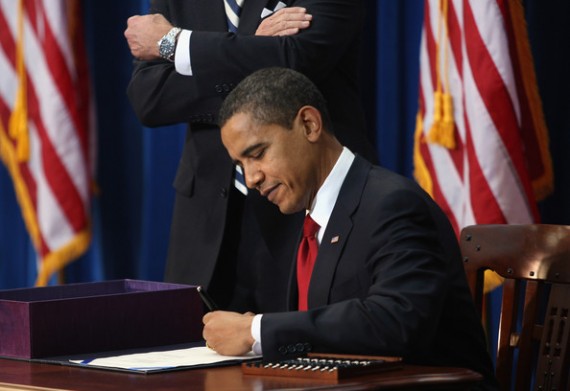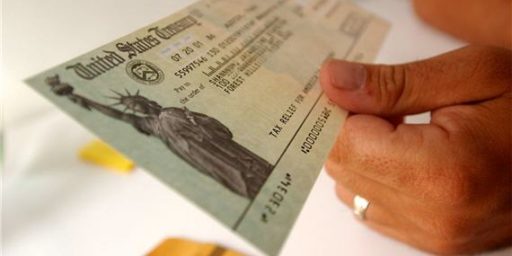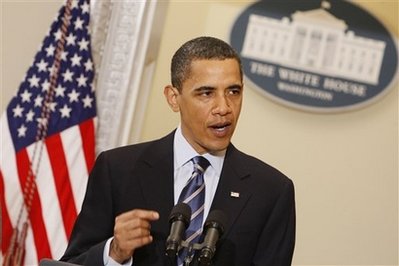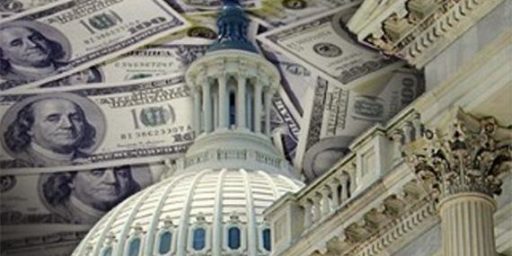The Final Verdict On The 2009 Stimulus: A Failure
President Obama smiled as he signed the 2009 stimulus into law, but the results aren't anything to smile about.
The final verdict is in on the 2009 stimulus bill, and it’s pretty clear that the entire thing was one massive boondoggle:
When the Obama administration releases a report on the Friday before a long weekend, it’s clearly not trying to draw attention to the report’s contents. Sure enough, the “Seventh Quarterly Report” on the economic impact of the “stimulus,” released on Friday, July 1, provides further evidence that President Obama’s economic “stimulus” did very little, if anything, to stimulate the economy, and a whole lot to stimulate the debt.
The report was written by the White House’s Council of Economic Advisors, a group of three economists who were all handpicked by Obama, and it chronicles the alleged success of the “stimulus” in adding or saving jobs. The council reports that, using “mainstream estimates of economic multipliers for the effects of fiscal stimulus” (which it describes as a “natural way to estimate the effects of” the legislation), the “stimulus” has added or saved just under 2.4 million jobs — whether private or public — at a cost (to date) of $666 billion. That’s a cost to taxpayers of $278,000 per job.
In other words, the government could simply have cut a $100,000 check to everyone whose employment was allegedly made possible by the “stimulus,” and taxpayers would have come out $427 billion ahead.
The White House has disputed this report:
The Council of Economic Advisers report, issued last Friday, states that in the first quarter of 2011, the stimulus bill “has raised employment relative to what it otherwise would have been by between 2.4 and 3.6 million.”
The White House has long disputed the math of dividing the cost of the stimulus by the number of jobs created – we asked a similar question back in October 2009, when that computation resulted in the comparable bargain of $72,408 per stimulus job, as you can read at this blog post.
Then, as now, White House officials note that the spending didn’t just fund salaries, it also went to the actual costs of building things — construction materials, new factories, and such. So the math is flawed, White House officials say, since reporters are not including the permanent infrastructure in the computation, thus producing an inflated figure. White House officials also questioned why the Weekly Standard would use the lower figure from the projection of the number of jobs created, and noted that the temporary nature of the stimulus bill meant that its impact would diminish over time, when the private sector began hiring again. In other words, the number of jobs created at its peak – as many as 3.6 million, according to the Congressional Budget Office’s May 2011 report – would be more appropriate, White House officials say.
Even if we’re generous and take that larger number, though, that leaves us with a ratio of stimulus spending to job “saved or created” of $185,000. Again, it would have been cheaper to just write a check to those people, and it might have actually had a more beneficial impact on the economy.
Hank Adler writes:
What should we have expected from the stimulus? Actually, what we should have expected was stimulus. For $800 billion, of course gross domestic product had to go up in the first quarter and at least someone should have been employed. But and it is a big but, the stimulus should have reduced overall unemployment and brought private investment dollars into the economy that would have sustained any short term economic gains from the stimulus. The real benefit of stimulus, not simply increased spending, should be appearing in current economic news. It is not.
And what should a new job cost? If 2.4 to 3.2 million jobs cost $800 million, that is a cost of $250,000 to $350,000 per job. It makes one ask for a more precise accounting of the spending. Shouldn’t we have expected more jobs? Weren’t we promised an unemployment rate of less than 8%? And there appears to be little or no sign that these jobs were not, in part, a continuation of state and city government jobs which are going to be lost in 2011 and 2012 due to state finances.
What is the solution now? Did we sell the seed corn by using up our borrowing opportunity and maxing out the nation’s debt?
It seems that we have. Not only is another $800,000,000 stimulus package out of the question politically, it is out of the question fiscally. We simply don’t have the money to try this again, and that particular outcome was fairly apparent at the time the bill was being debated. In retrospect, it’s clear that the promises the Administration made about the bill were completely unrealistic and that the unemployment picture would not be improving for a very long time, but of course that would have made people even more skeptical about spending money we didn’t have on the promise that “something” would happen.
There’s also a point to be made about the Administration’s “saved or created jobs” metric, and it’s one that Steve Verdon addressed back when the stimulus bill was being debated:
It is brilliant. Why? It is possible to measure how many jobs have been created between two points in time. However it is not possible to measure how many jobs were saved. These “saved jobs” never show up in any of the official statistics. As such It is a measure of performance that simply cannot be measured. Hence President Obama can claim it is true no matter if we lose 5 million jobs in the next year. Without his plan it would have been 9 million jobs lost.
I made a similar observation back in December 2008 when Obama was still just President-Elect:
Obama’s not saying that his policies will create 3 million new jobs. Heck, he’s not even really saying that his policies will create a single new job. As long as the Obama Administration can say two years from that they have “created or preserved” three million jobs, they can claim a victory.
Given the numbers that they’re relying upon, that essential means that unemployment can be at exactly the same level it is today, and Obama will be able to claim he’s “preserved” 3 million jobs.
Which is basically what they’ve done, isn’t it?
The economy is still stagnant not because the government isn’t spending enough money, but because there is still far too much uncertainty on the part of business owners and bankers, meaning they simply aren’t willing to take the economic risks that would lead to ventures that would restart the jobs engine. Some of that uncertainty is due to government policies implemented in the past two years, some of it is due to the fact that the world economy still seems to be teetering on the brink of something cataclysmic, and some of it is due to the fact that people just don’t think that things are going to get better anytime soon. Until that changes, no amount of “stimulus” is going to change anything.







Tune in next time on Doug Mataconis’ Problem Solving Through Primitive Intuition to hear Doug say: “You can take all the ‘chemotherapy’ you want, but that’s not going to get your humors balanced.”
Dow on the day the Obama signed the stimulus bill – 7,552.60
Dow today – 12,626.55
That’s up 67%
Who could have predicted this at the time? Besides Steve Verdon. And Drew. And me. Go ahead, look up the comments from the time ARRA was passed. I’ll wait.
I take no pleasure in being right about this, but it took a rather alarming and discouraging amount of dopey-hopey-changy kool-aid to believe all this neo-Keynesian nonsense from the very beginning, and even that gives undue credit to the sincerity of the attempt to begin with instead of treating it as another looting party by the poltically connected from the federal trough.
Flame away, but it won’t change the results.
Hell, it could have been worse. If Democrats had not gotten squashed last November right now we’d be looking down the barrel of “Stimulus” 2.0.
Two other points are worth appending to his excellent post: (1) the decision by FASB to eliminate mark-to-market accounting has turned the banking sector into a giant Ponzi scheme. When it implodes it’ll make 2008 look tame by comparison; (2) the Fed’s reckless policies since Rambobama was elected will be more damaging long term even than the Porkulus boondoggle. Right now the Fed is leveraged 53-1. If there’s even a tiny spike in short-term market interest rates the Fed will have to reverse the entire scope of QE1 and QE2 to avoid its balance sheet imploding. That in turn will spike long-term rates and then the economy quickly will devolve from disastrous to cataclysmic. We might actually see U-6 unemployment above 20%.
I remember when the stimulus formed up, and I called it a “split the difference” plan.
I said that it was more than the few right-wing hardliners wanted (zero stimulus) but it was also about half what the few left-wing hardliners wanted (Krugman’s $3T). I said then that we’d get a middle result, and we have.
But it is really stupid for the zero-stimulus folks to bounce back with this as a win for them, with unemployment at 9%, and a fairly mired economy.
No, you idiots, to prove stimulus unnecessary you should show how the economy blew back into health, and would have done so without all that unnecessary spending.
With a mired economy you are really showing the opposite, that it wasn’t enough.
… since reporters are not including the permanent infrastructure in the computation, thus producing an inflated figure
It’s obviously not just reporters that are ignoring this point.
Shorter: With a time machine you’d have two choices for change, less stimulus and more unemployment, or more stimulus and less unemployment.
Are you really arguing that less stimulus would have yielded more jobs? Or are you just relying on economic illiteracy, and that no one will connect the dots?
Doug,
Who exactly is causing all the uncertainty? I guess the constant brinksmanship on the debt ceiling, the lawsuits over heath care reform, are all the doing of the Democrats?
I guess this proves that tax cuts are a failure when it comes to improving the economy since close to 40% of the stimulus bill was tax cuts. Maybe Obama shouldn’t have compromised with the Republicans on that score.
I guess extending the Bush era tax cuts was also a failure. I mean we could have let them sunset and we would have been so much less in the hole.
I guess an economy that is growing (abet slowly) is much worse then an economy that is shrinking. Who knew.
By the way, Verdon was absolutely correct about this statement:
But some people here want it both ways, they say the stimulus ‘failed’ based on something that can’t be measured …
A more appropriate and truthful headline would have been “The Final Verdict on the 2009 Stimulus: Completely Unknown”.
Franklin makes a great point, you really need to subtract the value of the infrastructure improvements for the 278,000 per job figure to be anything more then a steaming pile of dog crap.
Even if we’re generous and take that larger number, though, that leaves us with a ratio of stimulus spending to job “saved or created” of $185,000. Again, it would have been cheaper to just write a check to those people, and it might have actually had a more beneficial impact on the economy.
You ignore the part you quoted:
Then, as now, White House officials note that the spending didn’t just fund salaries, it also went to the actual costs of building things — construction materials, new factories, and such. So the math is flawed, White House officials say, since reporters are not including the permanent infrastructure in the computation, thus producing an inflated figure.
It wasn’t only about jobs.
The uncertainty is a result of the unacknowledged primary factor of production: trust, or the one thing everybody is out of. The American people are well aware that systemic fraud now encompasses most of our economy, and they’re also aware that those with a large enough bank acount don’t go to jail for it. The failure to prosecute those who became wealthy at the expense of the rest of the country, and the explicit guarantee they’ll be bailed out again the next time they blow up the planet has firmly institutionalized looting. Combined with a civil court system designed to favor corporations with limitless pockets for litigation, and you have the worst possible environment for any business not large enough to be traded on Wall Street (which itself no longer functions to facilitate economic growth by transferring liquidity where it can bet be put to use).
So long as these conditions persist there will be no recovery.
@Doug
The authors of the report don’t share your opinion, Doug:
But do continue to consult with the editors of The Weekly Standard for their gloss on the language of the report. They are widely admired for their disinterested reporting and lack of bias concerning things Obama.
Seriouosly – you link to the Weakly Standard? The most partisan rag on the planet. The Fox News of print? I think they also mentioned WMD being found in Iraq. They also say that fossil fuels are renewable energy. Unflippingbelievable.
Anyway – by this (flawless) logic the newly re-paved highway I drive on every day has zero value. Terrific. If paving is free then I say we pave every single friggin’ highway in the country. And if by chance any costs are incured simply invoice Mataconis. Let him deal with the Weakly Standard.
Franklin,
I think the issue is whether the package worked as a Keynsian stimulus. The package may have had non-stimulus benefits. I believe extending unemployment benefits was a good policy for basic humanitarian reasons, whether stimulative or not. I also don’t think it was a bad idea to cut taxes to help families balance their books, even though it appears that the tax cuts did not get spent and did not stimulate the economy.
If someone wants to argue that patching highways was an indpedent good, have at it. I don’t believe it.
@hey norm: Maybe this is why Republicans in Congress are trying to slash highway construction funds by two thirds while raising military spending.
I’ve seen this line thrown around a lot with no evidence that it’s true, though it probably has a great feeling of truthiness to it. I’d also expect the same people who use this line to argue for a stimulus solely based on writing large checks to unemployment recipients the next time around.
PD…
I suggest you investigate the ways stimulus $$$ was spent in your state.
Laying it all on patching highways is disingenuous at best.
@PD Shaw: Fair enough. Like the WH did, I was mainly criticizing the idea of dividing the price by the number of jobs and claiming that metric means something significant.
So did it work as a Keynesian stimulus? I don’t think we can really know that, either – where would the economy be right now without it? As ponce pointed out, the Dow is up 67%. Would that have been 17%, 67%, or 117% without the stimulus? Would unemployment be 5%, 9%, or 20%? Predicting this crap is next to impossible, even for seasoned economists.
hey norm, I’m very familiar how construction money was spent in my state, having friends and family working for the state highway authority. They describe it as primarily patch-work, including re-suracing at least one road that didn’t need it. That’s because a Keynsian stimulas needs to be quick (shovel-ready) and increase spending over the previous norm. These restrains are very limiting given how roads and bridges are planned and designed today.
Austin…
“…I take no pleasure in being right about this…”
You remind me of the guy standing on the dock ranting about the flat-earth as Columbus sails east from Spain. Amusing in a sad and pathetic way…but wrong just the same.
@Franklin: To paraphrase Krugman’s interpretation of the economic improvements made after Reaganomics: Even a dead cat will bounce.
I’m not going to argue that there was zero stimulus effect; I think some things were better than others and we would have been better off only doing (what we can see more clearly in retrospect) what was more effective.
@PD Shaw: Absolutely right. But the Republicans insisted on huge tax breaks being part of the stimulus and on capping it at some arbitrary figure, instead of doing all that was necessary.
PD…
I have no idea what state you live in…but in states I’m familiar with the money was spent on projects ranging far and wide from the state highway authority.
For instance in my state in addition to highways $$$ was spent on community health centers, rail line modernization and improvements, airport improvements, energy block-grants, lead hazard reduction, development and improvement of public housing.
But my favorite by far was $9M spent completing a greenway rails-to-trails system and streetscapes in several towns.
My guess is that your “friends and family working for the state highway authority” and Mataconis and the Weekly Standard are simply not aware of these things, and the concept of capital improvements and investment.
“The Final Verdict On The 2009 Stimulus: A Failure”
It’s frustrating to read this headline coming off the heels of your Casey Anthony post.
Your conclusion of the stimulus is based on shoddy evidence from a biased Weekly Standard article and is used as an appeal to emotion towards those who are looking for confirmation of their preconceived notions.
It’s great that you’re wary of the ways Headline News uses an appeal to emotion to sell it’s product. But it’s disturbing the way you ignore this as a political blogger when it’s convenient for you to make a point that fits with your ideology.
“The people who have spent the last three years thinking they “know” Casey Anthony is guilty, don’t really know anything.” -Doug Mataconis
The same should be said of anyone forming any opinions from this poorly thought out blog post and the Weekly Standard article you cite.
jobs werent created becuase the funds were misapplied…
where do you see job creation in this?
American Recovery and Reinvestment Act of 2009
Summary of Major Spending and Revenue Provisions
(Billions of Dollars)
Major Spending Components:
State Fiscal Stabilization Fund……………………………………………….
$53.6
Enhanced Federal Medicaid Match Rate………………………………….
86.6
Transportation Infrastructure………………………………………………….
48.0
Other Infrastructure Grants…………………………………………………….
72.0
Investments in Health Programs…………………………………………….
14.2
Energy-Related Programs……………………………………………………..
37.5
Education and Training Programs…………………………………………..
52.3
Unemployment Insurance Expansion………………………………………
35.8
Health Insurance for Unemployed Workers………………………………
24.7
All Other Areas of Spending…………………………………………………..
75.7
Total Spending Components……………………………………………….
$500.4
Tax Revenue Components:
Individual Tax Relief……………………………………………………………..
$232.4
Business Tax Relief………………………………………………………………
34.2
Energy-Related Tax Issues……………………………………………………
20.0
Total Revenue Components………………………………………………..
$286.6
Total Federal Stimulus………………………………………………………..
$787.0
” it would have been cheaper to just write a check to those people, and it might have actually had a more beneficial impact on the economy.”
This is true, it would have been more beneficial. All this “shovel ready infrastructure” and tax cut stuff was largely political cover. And with Mitch McConnell’s gang hanging tight in the Senate, it was necessary cover in order to get anything at all. So what exactly was your point?
I am not a highway engineer, but it’s hard to imagine a resurfacing that does not extend the time before next service. Thus less work and crowding out later.
It’s like taking your car in for an oil change. Maybe you could have waited, but now you don’t have to worry for a while.
Unless it is a brand new road, with zero miles on it, there is benefit.
rjs, you are claiming what I call “immaculate spending,” the idea that government can spend even one billion without any people, any jobs, being involved.
How does that work, seriously?
You say “education and training,” for instance. How do you do that without teachers?
Our city got some money to repair the roads and open up a new 9th grade campus for the high school, which I would hardly call ‘waste’. Of course, fiscal policy is pretty ineffective at macroeconomic stabilization if the central bank is too focused on barely existent and below-target inflation. It would have been better to have done something smaller and more focused on infrastructure, justifying it with historically low interest rates rather than as some kind of miracle economic magic bullet.
I think it’s also important to specify that ‘uncertainty’ is largely due to a lack of demand (see your favorite survey about the biggest problems facing small businesses – weak sales) We’re lucky that the Fed in the US has at least done more than the BOJ has done for the last 20 years or that the US is a pretty well integrated currency union (unlike the EU). At the same time, with core inflation running so low, there’s plenty of room for more monetary stimulus to prevent cyclical unemployment from becoming structural unemployment.
@PD Shaw: Is your Avatar from The Amazing Screw-On Head? I just saw that as a clip on i09….cool!
The biggest problem was that the Stimulus package was dedicated 1/3 to tax cuts, that probably had very little stimulative effect. Moreover, net government spending never went up all that much as state and local governments pulled back (and continue to lead the way in decreasing aggregate GDP.) The stimulus package in the long run has almost no effect on the deficit or our debt. That’s just wishful thinking among those that don’t want to admit the big driver is clearly tax cuts. If we got rid of the Bush tax cuts and end significant combat operations in the Middle East our medium-term deficit disappears.
john personna, the practical reality is this. The feds don’t have the infrastructure to spend the kind of money that Krugman wants, they have to rely on the existing structures. In most large states, administration of road improvements is performed in regional districts. On the one hand, this improves administration by having state employees near the construction sites; the added bonus is spreading money to various political districts across the state.
In many states, federal money was simply pumped into this system using the “peanut-butter approach, taking the dollars and spreading them around very thinly, rather than taking the dollars and concentrating them where the most complex transportation problems are.”
The example I gave of unnecessary re-surfacing roads was in an area of the state facing long-term economic stagnation and decline. The road didn’t need resurfaced because there’s not much activity occurring. I am guessing that there really weren’t any good ideas for how to spend that money otherwise. No jobs were created in the area because the construction crews were from other, growing parts of the state, and no matter how nice the roads are, it won’t reverse longer-term urbanizing trends.
@Robert in SF: Yes indeed; you’re the first person to write that they recognized it. I’m a big Mike Mignola fan (and Abraham Lincoln of course).
That lack of trust extends to the government and is helped when many members of one of the major political parties constantly trash anything and everything that the government does…it is fascinating that so many of the same people who do everything they can to become part of the government spend so much of their time trashing their very own institution…
My point is not that useful things were not created with the stimulas money; it’s that such outcomes were incidental, not planned. AFAIK, the standards for getting most of the stimulus money were (a) that the project was not already planned, (b) it could be completed within the designated timeframe, and (c) it would create or retain jobs. There was no requirement that the end result be of value.
PD, isn’t that the “everybody’s stupid” defense?
No one spent a sensible dollar?
http://www.stanford.edu/~johntayl/JEL_taylor%20revised.pdf
John B. Taylor also argues that the stimulus package provided no stimulus.
@PD Shaw: I am pleased with all dead cat analogies.
PD… I live in the SF Bay Area, and there have been stimulus funded infrastructure projects all over the place, some of them critical. Take the Caldecott Tunnel for example:
http://www.caldecott-tunnel.org/index.php/traffic
So, what do we get for stimulus money spent on the tunnel’s fourth bore?
Economic activity related to a major infrastructure project – jobs, business for suppliers, nearby restaurants, so on & so on.
A lot less wasted gas in cars stuck in traffic 365 days a year.
A lot less pollution from cars stuck in traffic 365 days a year.
And all the hours mentioned above given back to drivers – 365 days a year. Add up the value of those hours. It’s a real number.
I live here. Believe me, this is a huge win for the area, this project had been on hold forever. Personally, I am sending a shout out to Obama for helping us to make it happen.
Why do Republicans only favor infrastructure projects when they are in Iraq?
@Steve Verdon:
I’m economically challenged, so bare with me. But I’m having some trouble with his figures and his counterfactual simulation. I was under the impression the 2009 stimulus package began in Quarter 3, 2009. He’s using Quarter 4, 2008 as the beginning of ARRA Grants and as a basis for his counterfactual simulation. How were these Grants rewarded before the stimulus was passed?
@alkali:
One reason the stimulus failed is because it was too small, as serious economists said all along. Another reason is that Repubs demanded that 30+ % of it be in the form of tax breaks, after 8 years of tax breaks resulted in a Great Recession.
Also, much of it went to states, which used it to reduce deficits, thus “saving” some unknown number of jobs, at least for a while.
i also disagree with the conventional Beltway idea that we cannot afford another stimulus, in the form of direct employment on infrastructure projects. America is as wealthy as ever, it’s just that over the last 30 years much more of the wealth is “stuck” at the top, where it does not create demand. And we always have unlimited dollars to spend on infrastructure (mostly permanent bases) in Afghanistan!
I think what we see in these discussions is that there some who have as their political identity that “government never does anything right.” If you know that in your soul, it will be pretty easy for you to find reasons that stimulus never did anything right.
Strange that “government does everything right” ideologues are absent, leaving “some right” as the “other” position.
The first article quoted alone makes my head hurt. $278,000 per person.. right. Because jobs are obviously performed with no equipment, training, or other capital costs.
Cheaper to write a check… Jesus. this isn’t even getting into the fact that half the stimulus was tax cuts. People DID GET CHECKS.
Economic uncertainty… uh that’s the entire point behind government spending. Because the private industry won’t spend. I mean that’s the entire damn philosophy.
Screw it, I’m through.
Here is some more technical information on the stimulus failure and why it is a larger failure than most people think.
How’s that Stimulus Working for You?
Another problem is that the most of the stimulus money went to bureaucracies that never had had any “shovel ready” projects.
Why should we be any more suspicious of government spending in GDP than we are pop music in GDP?
GDP is a very rude measure in all categories, but the whole point of it is to count dollars and avoid value judgements.
john personna said,
Because of nonsense like this
How Effective Was The 2009 Stimulus Program?
The underlying paper only actually examines projects with “$231.7 million in Federal support” Even if their methods were correct, you are asking a lot for us to extend $230M to the full $1,200,000M in stimulus.
That’s crazy.
What’s really going on is that Forbes found $230M they could spin in such a way that you just thought it applied to the full $1.2T
Think how much faster they’ll be able to access their favorite militia websites, though! Net benefit if you ask me.
DMan,
There was a stimulus package under Bush as well. It was mainly via taxes, and it took effect much sooner, hence his starting point. He also uses data going back to 1969 to make sure there is enough historical data to establish baselines and such.
@Steve Verdon:
I’m referring to the portion where he references ARRA grants alone, yet includes figures predating the 2009 stimulus. Specifically, in figures 4-9 he is referring to the 2009 stimulus in his analysis and conclusions, yet begins his counterfactual simulation 3 quarters before it was passed. His counterfactual is a simulation of what supposedly would have happened without the passage of ARRA, yet the plausibility of his simulation should be questioned since there is an obvious deviation from the historical data during those 3 quarters before it was even passed.
It’s likely that I’m failing in my understanding of his analysis in some way, but given my reading of him, and a look at his past writings, he appears to have more of an agenda than an honest analysis.